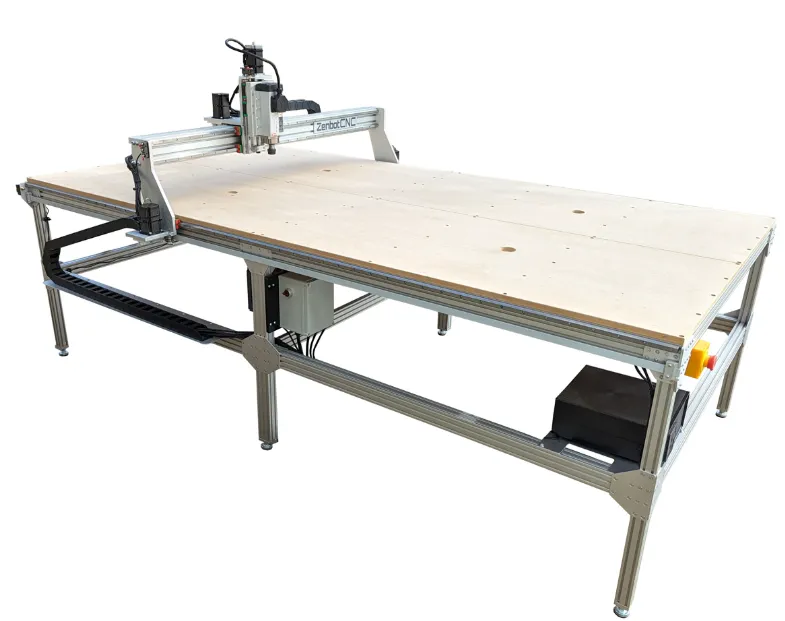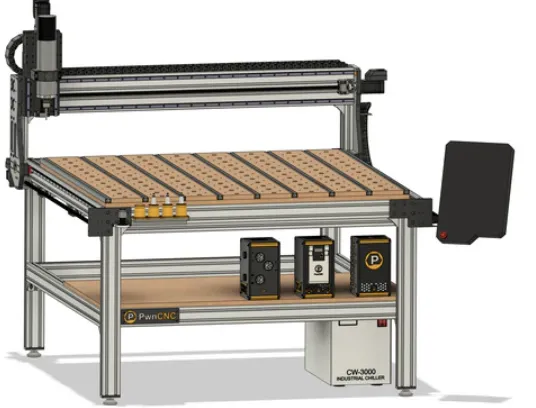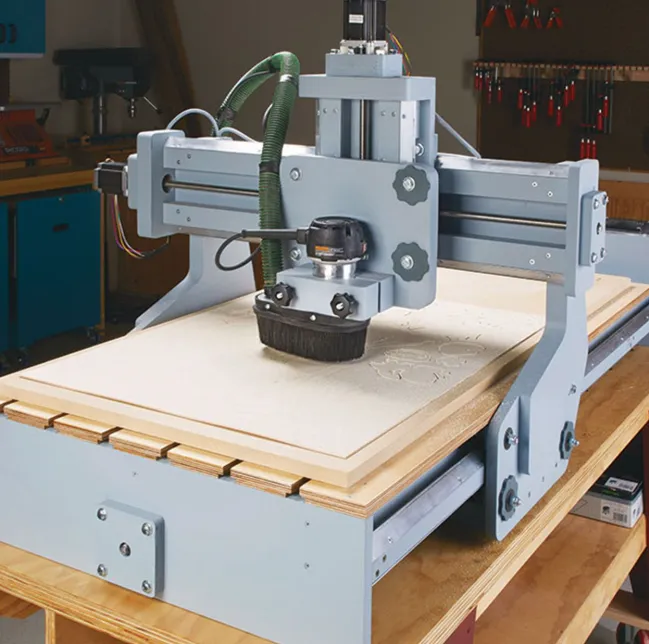CNC router tables represent a cornerstone of modern manufacturing, offering unparalleled precision and flexibility in cutting, carving, and machining a wide range of materials. These computer-controlled systems transform digital designs into physical components with exceptional accuracy, making them indispensable in industries ranging from woodworking and metal fabrication to aerospace and sign-making. At the heart of every CNC router table lies a robust mechanical structure—typically constructed from welded steel or aluminum—designed to withstand cutting forces while maintaining dimensional stability. The gantry-style configuration, with its moving bridge spanning a stationary work surface, provides the foundation for precise tool movement across multiple axes. Modern CNC routers commonly feature three primary axes of motion (X, Y, and Z), though advanced models may incorporate additional rotary axes for complex 3D machining. The integration of high-performance servo or stepper motors, coupled with precision ball screws or rack-and-pinion drives, enables positioning accuracy within ±0.025mm, ensuring that even the most intricate designs are reproduced faithfully.
 The cutting performance of a CNC router table depends heavily on its spindle system, which serves as the workhorse of the machine. Air-cooled spindles, ranging from 1.5kW to 15kW in power, are commonly employed for their simplicity and effectiveness in handling materials like wood, plastics, and non-ferrous metals. Liquid-cooled spindles offer superior thermal stability for prolonged heavy-duty machining, particularly in industrial settings where continuous operation is required. Spindle speeds typically vary between 8,000 and 24,000 RPM, allowing operators to optimize cutting parameters based on material type and tooling requirements. Automatic tool changers (ATCs) have become a standard feature on production-grade machines, enabling uninterrupted machining by swapping tools from a carousel or magazine with 6 to 24 positions. This capability significantly enhances productivity, especially when processing complex parts that require multiple tool types—from roughing end mills to fine engraving bits.
The cutting performance of a CNC router table depends heavily on its spindle system, which serves as the workhorse of the machine. Air-cooled spindles, ranging from 1.5kW to 15kW in power, are commonly employed for their simplicity and effectiveness in handling materials like wood, plastics, and non-ferrous metals. Liquid-cooled spindles offer superior thermal stability for prolonged heavy-duty machining, particularly in industrial settings where continuous operation is required. Spindle speeds typically vary between 8,000 and 24,000 RPM, allowing operators to optimize cutting parameters based on material type and tooling requirements. Automatic tool changers (ATCs) have become a standard feature on production-grade machines, enabling uninterrupted machining by swapping tools from a carousel or magazine with 6 to 24 positions. This capability significantly enhances productivity, especially when processing complex parts that require multiple tool types—from roughing end mills to fine engraving bits.
Workholding systems on CNC router tables have evolved to accommodate diverse material formats and production needs. Vacuum tables, divided into independently controlled zones, provide secure clamping for sheet goods like plywood, MDF, and acrylic without obstructing tool access. T-slot tables offer versatility for mechanical fixturing of solid wood blocks, aluminum plates, or composite panels, while specialized pin-based systems facilitate precise positioning of pre-cut blanks. Advanced router tables may incorporate probing systems that automatically detect workpiece location and orientation, compensating for material inconsistencies or imperfect alignment. Dust collection and chip extraction systems play a critical role in maintaining clean working conditions and preserving machine components, with high-volume suction systems capturing up to 99% of particulate matter generated during cutting operations.

The true power of CNC router tables emerges through their software ecosystem, which bridges the gap between digital design and physical production. CAD/CAM software packages like Vectric Aspire, Fusion 360, or RhinoCAM allow designers to create intricate 2D and 3D models that are translated into machine-readable G-code. Post-processors customize this code to account for specific machine kinematics, tool libraries, and material properties. Operators can simulate toolpaths virtually to detect potential collisions or inefficient cutting patterns before material is committed. Modern control systems, such as Mach3, LinuxCNC, or proprietary industrial controllers, provide intuitive interfaces for job setup and monitoring, with some offering touchscreen operation and real-time adaptive feed rate adjustment. The integration of tool length sensors and laser positioning systems further automates setup procedures, reducing human error and accelerating production workflows.

Material versatility stands as one of the most compelling advantages of CNC router tables. In woodworking applications, these machines excel at producing cabinet components, decorative moldings, and intricate inlays with joinery tight enough to eliminate visible seams. Plastic fabrication benefits from the router’s ability to cleanly cut acrylic, polycarbonate, and PVC for signage, displays, and industrial components. Aluminum and other non-ferrous metals can be machined using specialized carbide tooling and appropriate cutting parameters, making router tables valuable for prototyping and low-volume aerospace parts. Composite materials like carbon fiber and fiberglass require dedicated tooling and dust extraction but can be precision-trimmed for automotive and marine applications. Even advanced materials like foams, waxes, and certain ceramics fall within the capabilities of properly configured CNC routers, demonstrating their remarkable adaptability across manufacturing sectors.
Industrial applications of CNC router tables span an impressive spectrum of production scenarios. Furniture manufacturers rely on them for mass-customization of architectural millwork and bespoke joinery solutions. Sign-making shops utilize router tables to produce dimensional letters, logos, and textured panels with crisp edges ready for finishing. The automotive industry employs large-format routers for creating molds, patterns, and interior components, while the marine sector machines hull plugs and decking elements. Musical instrument builders achieve unprecedented consistency in guitar bodies, piano actions, and wind instrument components through CNC routing. Even in artistic domains, router tables enable the creation of elaborate bas-relief sculptures and decorative panels that would be impractical to produce manually. This breadth of application underscores the technology’s transformative impact on both traditional craftsmanship and industrial production.

Technological advancements continue pushing the boundaries of CNC router capabilities. Hybrid machines that combine additive and subtractive processes are emerging, allowing for innovative fabrication techniques that build up material in some areas while machining others. Improved scanning systems enable reverse engineering of physical objects for reproduction or modification, while AI-driven toolpath optimization algorithms are beginning to reduce programming time and material waste. The Internet of Things (IoT) connects router tables to networked monitoring systems that track machine health, predict maintenance needs, and optimize production scheduling. These innovations build upon the router table’s fundamental strengths while opening new possibilities in digital fabrication.

From small shop desktop models to industrial-scale gantry systems spanning 20 feet or more, CNC router tables have democratized precision manufacturing across scales. Their continued evolution reflects broader trends in automation, digital workflow integration, and sustainable manufacturing practices. As material science introduces new substrates and composites, and as software becomes more sophisticated in simulating physical machining behaviors, CNC router tables will undoubtedly maintain their position as essential tools in the modern maker’s arsenal—equally at home in artisan workshops and high-volume factories alike. The technology’s ongoing development promises to further blur the lines between digital design and physical realization, ensuring its relevance in the next generation of manufacturing innovation.




